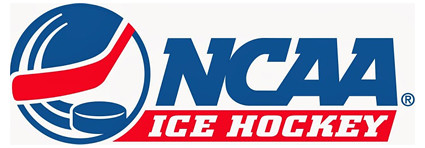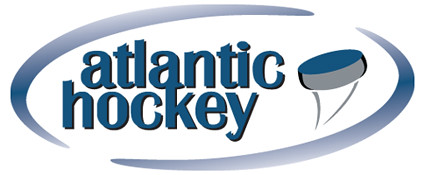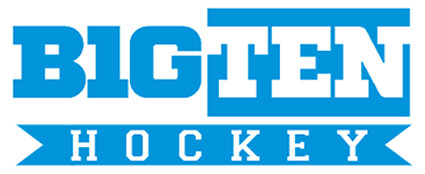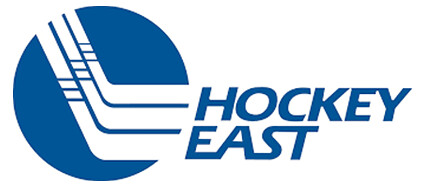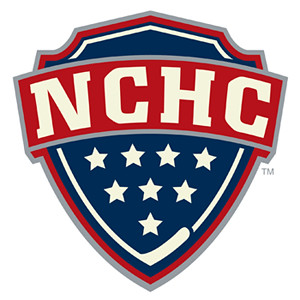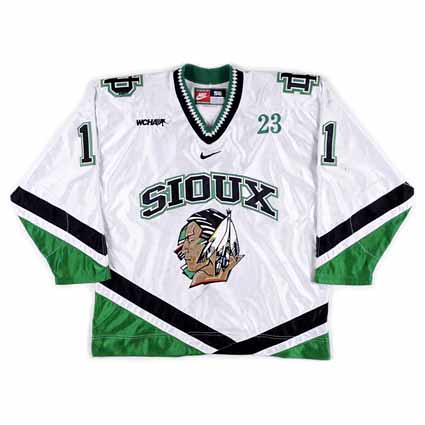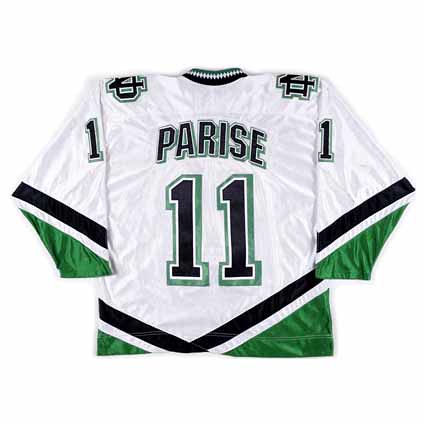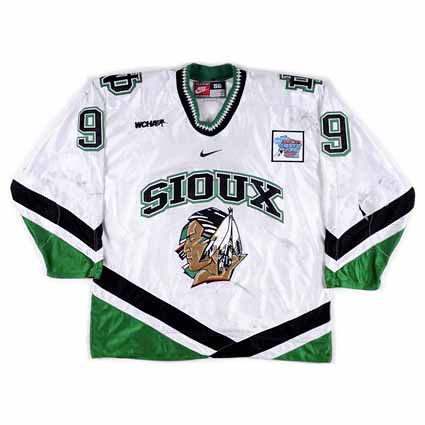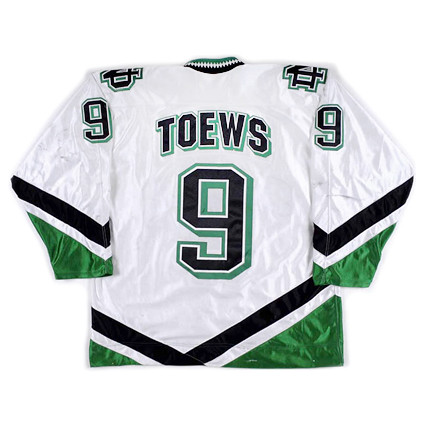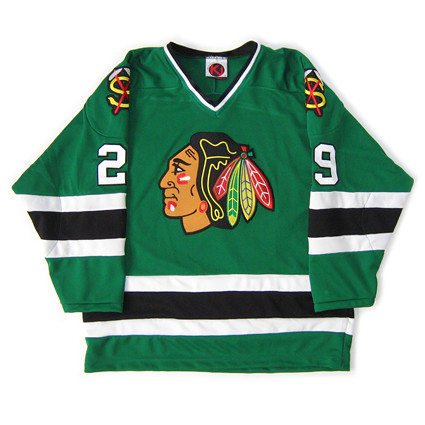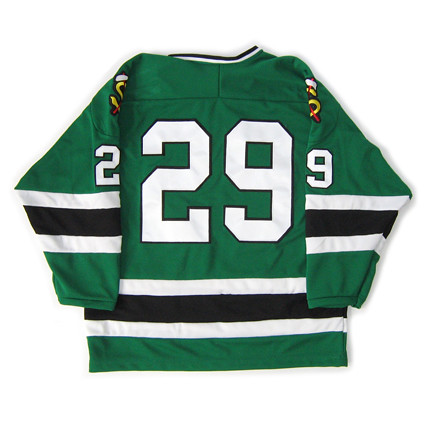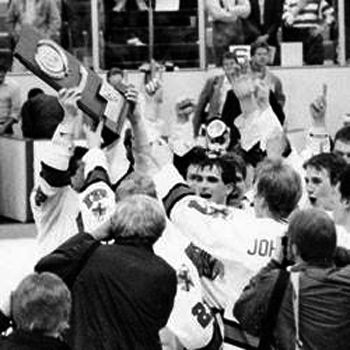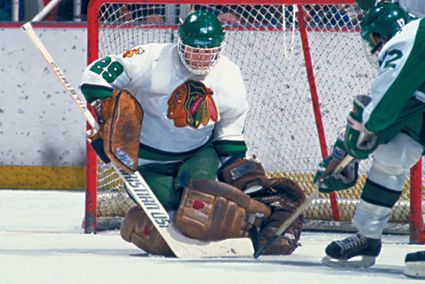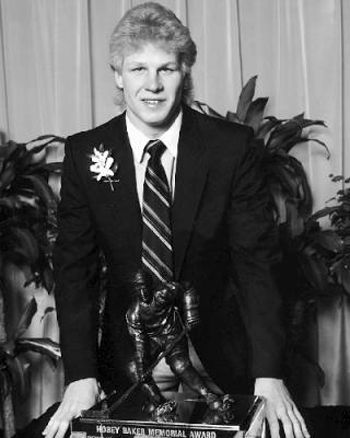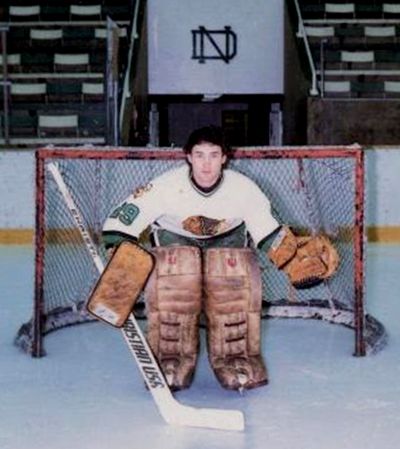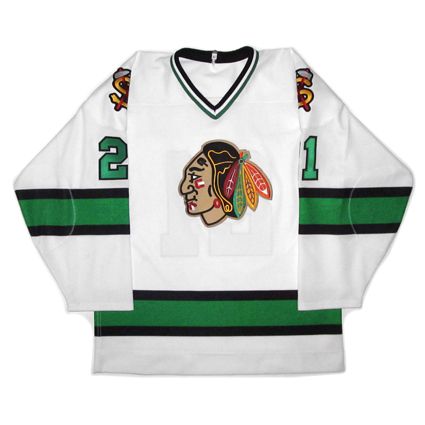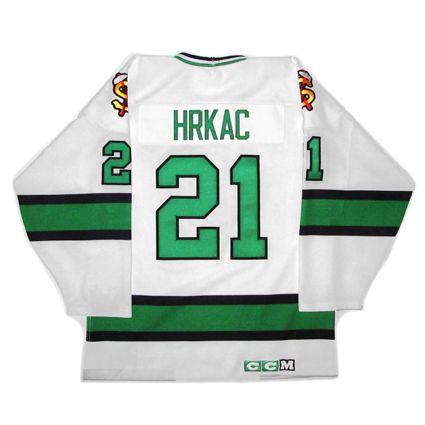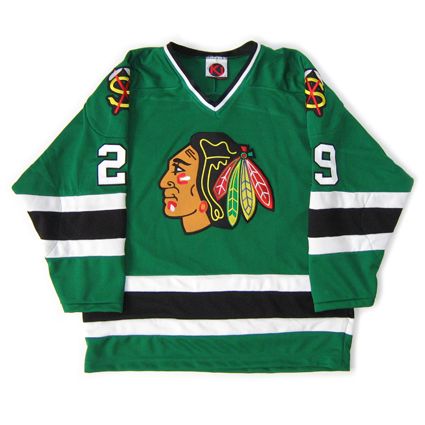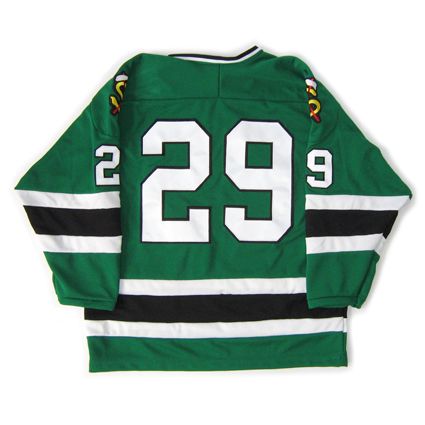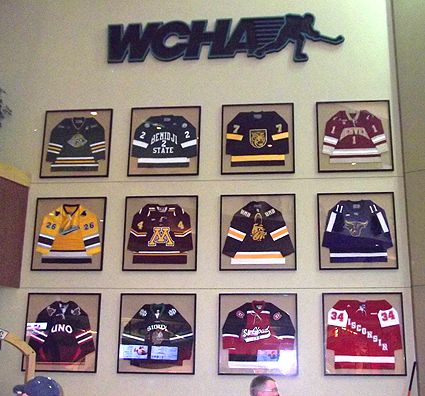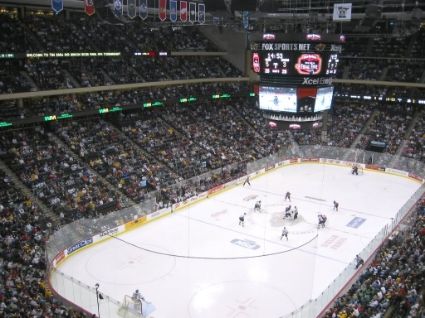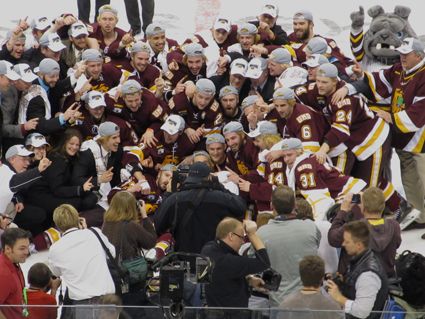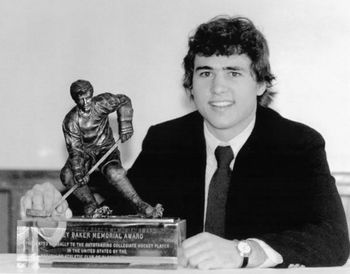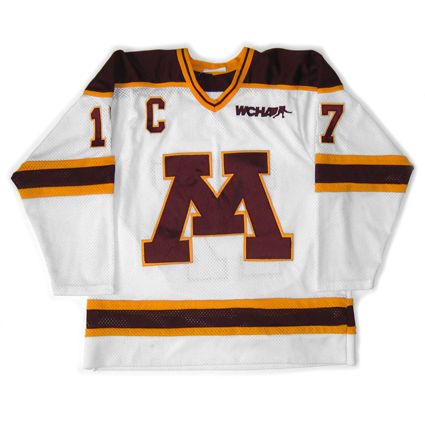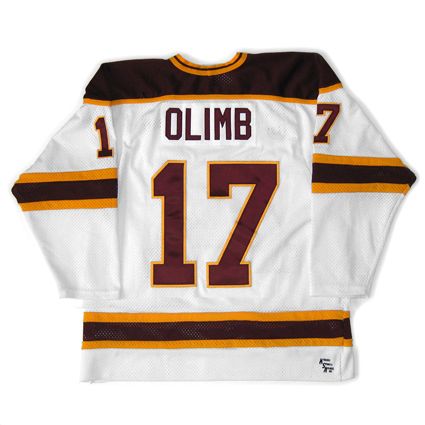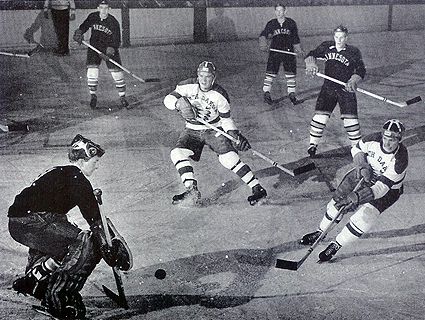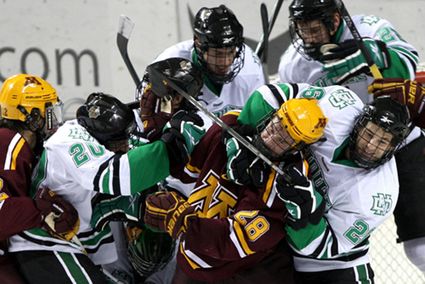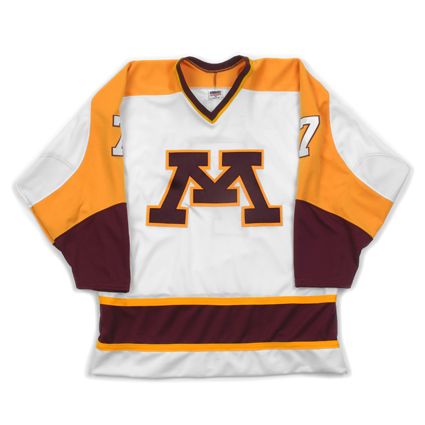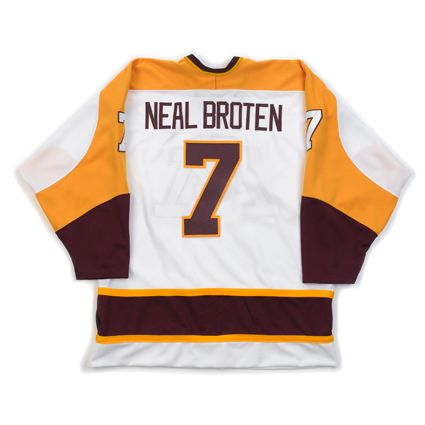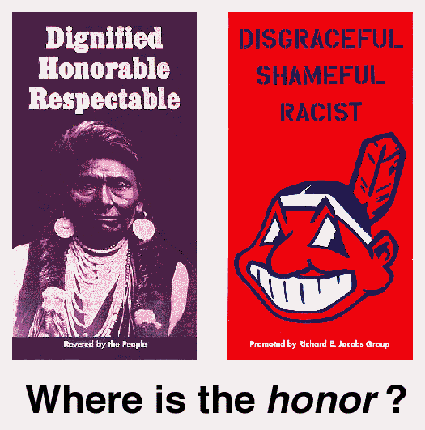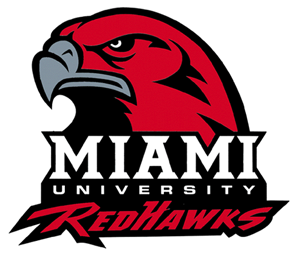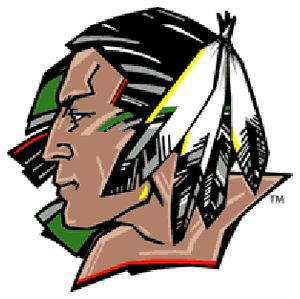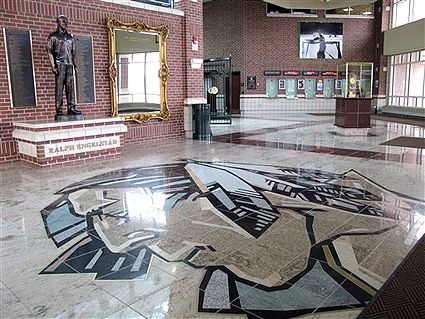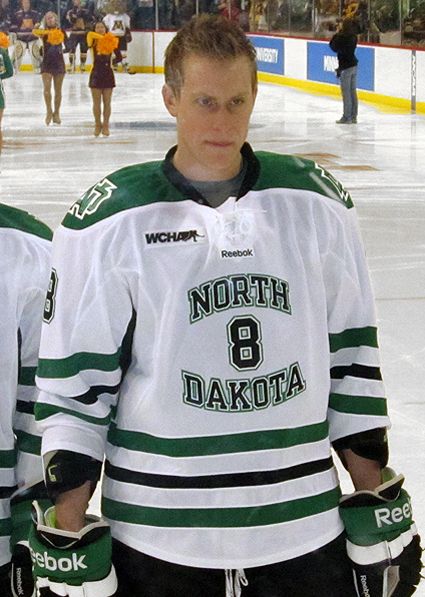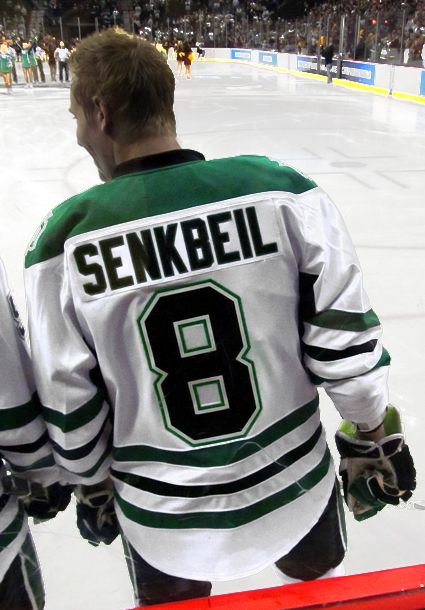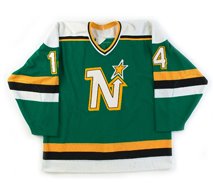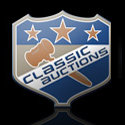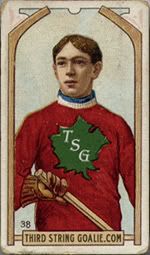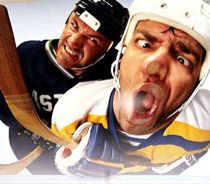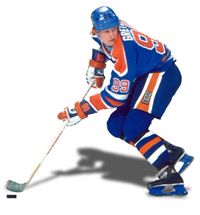Showing posts with label University of North Dakota. Show all posts
Showing posts with label University of North Dakota. Show all posts
Friday, March 17, 2017
2017 NCAA Conference Tournaments
Last night began the final weekend of play in the six NCAA men's collegiate hockey tournaments to award each conference's automatic bid for the national championship playoffs, which will see four regionals take place on March 24th, 25th and 26th with the Frozen Four in Chicago, Illinois on April 6th and 8th at the home of the Chicago Blackhawks, the United Center.
The field for the national championship is open to 16 teams as determined by the NCAA's computer ranking system. The fly in the ointment is that the top 16 teams do NOT automatically advance to the national playoffs, as both the Western Collegiate Hockey Association and Atlantic Hockey Association conferences eventual playoff winners will both be from well outside the top 16 and the champions of those conference playoff tournaments are guaranteed take one of the 16 available spots in the national playoffs, narrowing the available openings to now 14.
Furthermore, if any of the other four tournaments see an upset winner from lower in the computer rankings, another place will be lost to the teams "on the bubble" hovering around 12th to 14th place in the NCAA computer rankings.
The first group of teams affected the most by this system are the winners of the various conferences regular season championships, which guarantees them absolutely nothing when it comes to post season play. Look no further than the WCHA regular season titlist the Bemidji State Beavers, who were dumped 4-3 in overtime last Friday and 2-1 on Saturday by the Bowling Green Falcons, ending the Beavers season, as they were only ranked 29th, far outside of the top 14 required for a possible place in the national tournament despite their regular season championship.
One team this year who has won their conference regular season title but will be required to win their conference's playoff tournament's automatic bid is the Canisius Golden Griffins of Atlantic Hockey, who are currently ranked 25th.
Taking a look at this weekend's competition by conference in alphabetical order, Atlantic Hockey sees regular season champions Canisius facing off against the Robert Morris Colonials (4th in the regular season) with the winner meeting the survivor of the second place Air Force Falcons versus the third place Army Black Knights, with all games taking place at the Blue Cross Arena in Rochester, New York. Again, with all four teams well outside the top 14 places in the NCAA rankings, it's all on the line as only the winner of the tournament will continue to play past this weekend.
The Big Ten tournament takes place this year at the Joe Louis Arena in Detroit, Michigan for the final time, as poor attendance in Detroit (in odd numbered years) and St. Paul, Minnesota's Xcel Energy Center (in even numbered years) will see future tournaments taking place on campus sites going forward. Last night, the #14 Ohio State Buckeyes kept their NCAA hopes alive with a 6-3 win over the Michigan State Spartans, while the #12 Penn State Nittany Lions advanced by defeating the Michigan Wolverines 4-1. Penn State now advances to play #5 Minnesota while Ohio State takes on the #18 Wisconsin Badgers, which highlights one of the quirks of the computer rankings, as both Ohio State and Penn State are ranked above Wisconsin in the computer ratings, despite Wisconsin finishing above both of them in the Big Ten regular season. While Penn State is a lock for the NCAA tournament at #12, Ohio State is in a must-win position tonight to improve on their #14 rating, which leaves them very much on the bubble if there are any major upsets this weekend nationwide. Wisconsin, at #18, simply must win the entire tournament to claim the league's automatic entry or their season is done.
The Eastern College Athletic Conference playoffs will take place at the Herb Brooks Arena in Lake Placid, New York with teams 1-Harvard Crimson, 2-Union Dutchmen, 3-Cornell Big Red and 5-Quinnipiac Bobcats taking part. With Harvard (#3), Union (#7) and Cornell (#9) all solidly in the NCAA tournament, teams and fans of teams on the edge of making the tournament will all have their fingers crossed that last year's national runner up Quinnipiac does not pull off the upset and claim the ECAC automatic entry to the NCAA's. To do so, they will have to defeat Harvard tonight and then the winner of the Cornell vs. Union matchup tomorrow.
The Hockey East tournament takes place at the TD Garden in Boston, Massachusetts with the UMass Lowell River Hawks (#8 nationally and Hockey East regular season champions) battling #10 the Notre Dame Fighting Irish. Notre Dame should be safe at 10th, but a win tonight is a guarantee to advance to the NCAA tournament. The other Semifinal has rivals #6 the Boston University Terriers squaring off against the tied for 15th Boston College Eagles, with the Eagles currently on the outs nationally and in a must-win position tonight. Even a win tonight may not be enough to secure a place in the national tournament field, as they may not move up enough to fend off an unexpected tournament winner elsewhere. Winning the Hockey East tournament would, of course, eliminate any questions about their place in the NCAA tournament, but likely cost a team like Ohio State or Penn State their place in the national championship tournament.
The National Collegiate Hockey Conference holds their tournament annually at the Target Center in Minneapolis, successfully surviving both the Big Ten and WCHA tournaments which used to be held across the river in St. Paul in alternating years. The field this year is by far the strongest in the nation, with regular season champion and computer #1 the Denver Pioneers facing off against #11 the defending national champion North Dakota Fighting Hawks, who finished the NCHC regular season in fourth. All the favorites won during the first round last weekend, and therefore, the #2 University of Minnesota - Duluth Bulldogs will square off against the #4 Western Michigan Broncos. Barring any huge upsets elsewhere, all four NCHC teams should advance to the national championship playoffs, with only North Dakota having to keep an eye on the out of town scoreboard should they lose tonight. The remaining three, Denver, Duluth and Western Michigan are all playing for bragging rights and a favorable NCAA seeding.
The final tournament is one that will have a certain affect on the national championship field, as the WCHA winner will be from outside the top 16 and claim a spot from a bubble team. The WCHA tournament has a new format this year, as the "Final Five" is no more. Previously alternating between St. Paul and Van Andel Arena in Grand Rapids, Michigan, the tournament is now simply held at the home rinks of the WCHA member clubs, with the theme "There's no place like home". As such, the WCHA tournament is on a decidedly different schedule than the other five conferences, as they began their opening round, best-of-three series back on March 3rd to 5th. Bowling Green, 4th in the league, advanced as did regular season champion Bemidji State, the 3rd place Minnesota State Mavericks and the 2nd place Michigan Tech Huskies. Those four teams then met last weekend, with Bowling Green upsetting Bemidji in two straight and Michigan Tech knocking out Minnesota State in three. That sets up Saturday's championship game between the #37 Falcons and #28 Huskies at Michigan Tech in a single game, winner-take-all-final for the automatic bid in the NCAA tournament.
There is one other teams aside from those we have not mentioned with a lot on the line this weekend, and that is the Providence Friars of Hockey East. The Friars are tied for #12 in the computer rankings but were eliminated from their league playoffs when they were thrashed 5-0 and 5-2 by Notre Dame. While Providence is currently 12th, the rankings are constantly in flux, as yesterday's wins by both Ohio State and Penn State, will likely drop the Friars down a notch or two, leaving them very much on the cusp of being knocked out of the NCAA's by just about any upset this weekend as they sit home, completely unable to defend their position on the ice.
We at Third String Goalie will be in attendance at the NCHC Frozen Faceoff and making regular updates on our twitter feed @3rdStringGoalie using the hashtags #NCHCHockey and #FrozenFaceoff with our usual combination of serious reporting, fun observations and sarcasm both Friday and Saturday, including a round or two of "Spot the Webmaster", as we post a picture of us wearing a jersey with a Third String Goalie hockey card for those who come up and say hi.
If you are a regular reader of Third String Goalie and do not follow us on Twitter, we invite you to join our 1,400 followers, as we post the occasional jersey news and live tweet various events we attend in addition to posting links to our daily blog entries.
Today's first featured jersey is a 2002-03 University of North Dakota Fighting Sioux Zach Parise jersey. The North Dakota hockey program dates back to 1929 and the program lasted until shut down due to the Great Depression in 1936. It was revived in 1946 and joined the forerunner of the WCHA in 1951. They won their first national championship in 1959 and again in 1963. They then had to wait until the 1980s when they won three more, in 1980, 1982 and 1987. It would be another ten years until they won again in 1997 before going on a run of ten Frozen Four appearances in the 2000s with championships in both 2000 and last year in 2016, their first after leaving the WCHA for the brand new NCHC in 2013 and since changing their name from the Fighting Sioux to the Fighting Hawks in late 2015 under pressure from the NCAA.
Today's second featured jersey is a 2002-03 University of North Dakota Fighting Sioux Jonathan Toews Parise jersey. The team has won 15 WCHA and 2 NCHC regular season titles and 11 WCHA playoff championships, qualifying for the NCAA tournament 30 times with 22 Frozen Four appearances that has resulted in 8 national championships.
Two North Dakota players, Tony Hrkac and Ryan Duncan, have won the Hobey Baker Award and numerous alumni have gone on to successful NHL careers, including Ed Belfour, Jason Blake, Dave Christian, Brock Nelson, T. J. Oshie, Zach Parise and Johnathan Toews among many others.
Today's third featured jersey is a 1986-87 University of North Dakota Fighting Sioux Ed Belfour jersey as worn by Belfour in his NCAA national championship season. No names were used on the back of the North Dakota road jerseys at that time and Belfour wore #29 in college rather than the more familiar #30 he would later wear in the NHL.
This classic Fighting Sioux jersey is clearly derived from the traditional Chicago Blackhawks jersey, only with the Blackhawks red replaced by the green of the Fighting Sioux and with the "C" in the crossed tomahawks secondary logo replaced by an "S".
A much beloved style among Fighting Sioux fans, this style was first used in 1978 and lasted through 1993 when political correctness resulted in a "North Dakota wordmark" style for a couple of seasons until stylized "geometric" Indian head was employed. While today's featured style came into being in 1984, the use of the "Blackhawks" crest dates back to 1971.
The field for the national championship is open to 16 teams as determined by the NCAA's computer ranking system. The fly in the ointment is that the top 16 teams do NOT automatically advance to the national playoffs, as both the Western Collegiate Hockey Association and Atlantic Hockey Association conferences eventual playoff winners will both be from well outside the top 16 and the champions of those conference playoff tournaments are guaranteed take one of the 16 available spots in the national playoffs, narrowing the available openings to now 14.
Furthermore, if any of the other four tournaments see an upset winner from lower in the computer rankings, another place will be lost to the teams "on the bubble" hovering around 12th to 14th place in the NCAA computer rankings.
The first group of teams affected the most by this system are the winners of the various conferences regular season championships, which guarantees them absolutely nothing when it comes to post season play. Look no further than the WCHA regular season titlist the Bemidji State Beavers, who were dumped 4-3 in overtime last Friday and 2-1 on Saturday by the Bowling Green Falcons, ending the Beavers season, as they were only ranked 29th, far outside of the top 14 required for a possible place in the national tournament despite their regular season championship.
One team this year who has won their conference regular season title but will be required to win their conference's playoff tournament's automatic bid is the Canisius Golden Griffins of Atlantic Hockey, who are currently ranked 25th.
Taking a look at this weekend's competition by conference in alphabetical order, Atlantic Hockey sees regular season champions Canisius facing off against the Robert Morris Colonials (4th in the regular season) with the winner meeting the survivor of the second place Air Force Falcons versus the third place Army Black Knights, with all games taking place at the Blue Cross Arena in Rochester, New York. Again, with all four teams well outside the top 14 places in the NCAA rankings, it's all on the line as only the winner of the tournament will continue to play past this weekend.
The Big Ten tournament takes place this year at the Joe Louis Arena in Detroit, Michigan for the final time, as poor attendance in Detroit (in odd numbered years) and St. Paul, Minnesota's Xcel Energy Center (in even numbered years) will see future tournaments taking place on campus sites going forward. Last night, the #14 Ohio State Buckeyes kept their NCAA hopes alive with a 6-3 win over the Michigan State Spartans, while the #12 Penn State Nittany Lions advanced by defeating the Michigan Wolverines 4-1. Penn State now advances to play #5 Minnesota while Ohio State takes on the #18 Wisconsin Badgers, which highlights one of the quirks of the computer rankings, as both Ohio State and Penn State are ranked above Wisconsin in the computer ratings, despite Wisconsin finishing above both of them in the Big Ten regular season. While Penn State is a lock for the NCAA tournament at #12, Ohio State is in a must-win position tonight to improve on their #14 rating, which leaves them very much on the bubble if there are any major upsets this weekend nationwide. Wisconsin, at #18, simply must win the entire tournament to claim the league's automatic entry or their season is done.
The Eastern College Athletic Conference playoffs will take place at the Herb Brooks Arena in Lake Placid, New York with teams 1-Harvard Crimson, 2-Union Dutchmen, 3-Cornell Big Red and 5-Quinnipiac Bobcats taking part. With Harvard (#3), Union (#7) and Cornell (#9) all solidly in the NCAA tournament, teams and fans of teams on the edge of making the tournament will all have their fingers crossed that last year's national runner up Quinnipiac does not pull off the upset and claim the ECAC automatic entry to the NCAA's. To do so, they will have to defeat Harvard tonight and then the winner of the Cornell vs. Union matchup tomorrow.
The Hockey East tournament takes place at the TD Garden in Boston, Massachusetts with the UMass Lowell River Hawks (#8 nationally and Hockey East regular season champions) battling #10 the Notre Dame Fighting Irish. Notre Dame should be safe at 10th, but a win tonight is a guarantee to advance to the NCAA tournament. The other Semifinal has rivals #6 the Boston University Terriers squaring off against the tied for 15th Boston College Eagles, with the Eagles currently on the outs nationally and in a must-win position tonight. Even a win tonight may not be enough to secure a place in the national tournament field, as they may not move up enough to fend off an unexpected tournament winner elsewhere. Winning the Hockey East tournament would, of course, eliminate any questions about their place in the NCAA tournament, but likely cost a team like Ohio State or Penn State their place in the national championship tournament.
The National Collegiate Hockey Conference holds their tournament annually at the Target Center in Minneapolis, successfully surviving both the Big Ten and WCHA tournaments which used to be held across the river in St. Paul in alternating years. The field this year is by far the strongest in the nation, with regular season champion and computer #1 the Denver Pioneers facing off against #11 the defending national champion North Dakota Fighting Hawks, who finished the NCHC regular season in fourth. All the favorites won during the first round last weekend, and therefore, the #2 University of Minnesota - Duluth Bulldogs will square off against the #4 Western Michigan Broncos. Barring any huge upsets elsewhere, all four NCHC teams should advance to the national championship playoffs, with only North Dakota having to keep an eye on the out of town scoreboard should they lose tonight. The remaining three, Denver, Duluth and Western Michigan are all playing for bragging rights and a favorable NCAA seeding.
The final tournament is one that will have a certain affect on the national championship field, as the WCHA winner will be from outside the top 16 and claim a spot from a bubble team. The WCHA tournament has a new format this year, as the "Final Five" is no more. Previously alternating between St. Paul and Van Andel Arena in Grand Rapids, Michigan, the tournament is now simply held at the home rinks of the WCHA member clubs, with the theme "There's no place like home". As such, the WCHA tournament is on a decidedly different schedule than the other five conferences, as they began their opening round, best-of-three series back on March 3rd to 5th. Bowling Green, 4th in the league, advanced as did regular season champion Bemidji State, the 3rd place Minnesota State Mavericks and the 2nd place Michigan Tech Huskies. Those four teams then met last weekend, with Bowling Green upsetting Bemidji in two straight and Michigan Tech knocking out Minnesota State in three. That sets up Saturday's championship game between the #37 Falcons and #28 Huskies at Michigan Tech in a single game, winner-take-all-final for the automatic bid in the NCAA tournament.
There is one other teams aside from those we have not mentioned with a lot on the line this weekend, and that is the Providence Friars of Hockey East. The Friars are tied for #12 in the computer rankings but were eliminated from their league playoffs when they were thrashed 5-0 and 5-2 by Notre Dame. While Providence is currently 12th, the rankings are constantly in flux, as yesterday's wins by both Ohio State and Penn State, will likely drop the Friars down a notch or two, leaving them very much on the cusp of being knocked out of the NCAA's by just about any upset this weekend as they sit home, completely unable to defend their position on the ice.
We at Third String Goalie will be in attendance at the NCHC Frozen Faceoff and making regular updates on our twitter feed @3rdStringGoalie using the hashtags #NCHCHockey and #FrozenFaceoff with our usual combination of serious reporting, fun observations and sarcasm both Friday and Saturday, including a round or two of "Spot the Webmaster", as we post a picture of us wearing a jersey with a Third String Goalie hockey card for those who come up and say hi.
If you are a regular reader of Third String Goalie and do not follow us on Twitter, we invite you to join our 1,400 followers, as we post the occasional jersey news and live tweet various events we attend in addition to posting links to our daily blog entries.
Today's first featured jersey is a 2002-03 University of North Dakota Fighting Sioux Zach Parise jersey. The North Dakota hockey program dates back to 1929 and the program lasted until shut down due to the Great Depression in 1936. It was revived in 1946 and joined the forerunner of the WCHA in 1951. They won their first national championship in 1959 and again in 1963. They then had to wait until the 1980s when they won three more, in 1980, 1982 and 1987. It would be another ten years until they won again in 1997 before going on a run of ten Frozen Four appearances in the 2000s with championships in both 2000 and last year in 2016, their first after leaving the WCHA for the brand new NCHC in 2013 and since changing their name from the Fighting Sioux to the Fighting Hawks in late 2015 under pressure from the NCAA.
Today's second featured jersey is a 2002-03 University of North Dakota Fighting Sioux Jonathan Toews Parise jersey. The team has won 15 WCHA and 2 NCHC regular season titles and 11 WCHA playoff championships, qualifying for the NCAA tournament 30 times with 22 Frozen Four appearances that has resulted in 8 national championships.
Two North Dakota players, Tony Hrkac and Ryan Duncan, have won the Hobey Baker Award and numerous alumni have gone on to successful NHL careers, including Ed Belfour, Jason Blake, Dave Christian, Brock Nelson, T. J. Oshie, Zach Parise and Johnathan Toews among many others.
Today's third featured jersey is a 1986-87 University of North Dakota Fighting Sioux Ed Belfour jersey as worn by Belfour in his NCAA national championship season. No names were used on the back of the North Dakota road jerseys at that time and Belfour wore #29 in college rather than the more familiar #30 he would later wear in the NHL.
This classic Fighting Sioux jersey is clearly derived from the traditional Chicago Blackhawks jersey, only with the Blackhawks red replaced by the green of the Fighting Sioux and with the "C" in the crossed tomahawks secondary logo replaced by an "S".
A much beloved style among Fighting Sioux fans, this style was first used in 1978 and lasted through 1993 when political correctness resulted in a "North Dakota wordmark" style for a couple of seasons until stylized "geometric" Indian head was employed. While today's featured style came into being in 1984, the use of the "Blackhawks" crest dates back to 1971.
Labels:
NCAA,
University of North Dakota
Saturday, March 28, 2015
1986-87 University of North Dakota Tony Hrkac Jersey
On this date in 1987, the University of North Dakota Fighting Sioux, led by 1987 Hobey Baker winner and national scoring champion Tony Hrkac and future NHL All-Star Ed Belfour, captured the NCAA championship at the Joe Louis Arena in Detroit, Michigan by defeating the Michigan State Spartans by a score of 5-3.
The NCAA tournament began with eight teams meeting in the quarterfinals, which were still a two-game, total-goals format.
The Minnesota Golden Gophers, second in the WCHA defeated the Boston College Eagles, the champions of Hockey East, 4-1 in the first game. While the Eagles would win the second game 3-2, Minnesota's three goal advantage from Game 1 stood up to take the series 6-4.
The Michigan State Spartans, second in the CCHA regular season and winners of their conference tournament, easily dispatched the Maine Black Bears 11-5 to advance to face Minnesota in the Final Four in Detroit, 90 miles from the Spartans' campus.
In the other half of the bracket, WCHA champions North Dakota took two from the St. Lawrence Saints, third in the ECAC, to win 9-4.
In the final pairing, the Harvard Crimson, champions of the ECAC, destroyed the CCHA champion Bowling Green Falcons in Game 1 by a score of 7-1, taking an insurmountable six goal lead into Game 2, which they easily won 3-0 for a final tally of 10-1.
Michigan State survived their semifinal game in Detroit against Minnesota 5-3, aided in part by a fluke goal when the puck caromed off the seam in the Zamboni doors behind the Minnesota goal, leaving Minnesota goaltender John Blue miles out of his crease waiting for the ring-around while the puck deflected into the slot for an easy shot into the unguarded net for the Spartans.
North Dakota advanced to the final with a stout 5-2 win over Harvard.
In the championship final, North Dakota prevailed by a score of 5-3 over the partisan Michigan State crowd which numbered an NCAA record 17,644 fans in attendance. Ian Kidd opened the scoring for North Dakota in the first period with a backhander before defenseman Murray Baron added another 1:37 later to make it 2-0 for the Fighting Sioux. Just 18 seconds later Bob Joyce scored from Hrkac and Kidd, North Dakota's third goal in the span of just 1:55.
Michigan State got a goal back in the second period, which North Dakota soon countered to restore the three goal cushion before future NHLer Kevin Miller scored for the Spartans to make it 4-2 after two periods.
Each team would add a goal in the third for the final score of 5-3 as the Gino Gasparini coached team earned their fifth national championship and set a record with their 40th win of the season to finish the season at 40-8.
Each team would add a goal in the third for the final score of 5-3 as the Gino Gasparini coached team earned their fifth national championship and set a record with their 40th win of the season to finish the season at 40-8.
Hrkac led the tournament in scoring with 3 goals and a record 9 assists for 12 points and was named to the All-Tourament team along with teammates Belfour, defnseman Kidd and linemate Joyce.
Hrkac also led the nation in scoring that season with 116 points in 48 games, far outdistancing his nearest competitor by 24 points to set an NCAA record, while Joyce and Hrkac finished 1-2 in goals with 52 and 46. Hrkac's outstanding season was recognized with the Hobey Baker Award, given annually to the top player in American college hockey also on this date in 1987.
Tony Hrkac posing with the Hobey Baker Award
After playing two seasons at North Dakota, Hrkac would immediately enter the NHL with the St. Louis Blues. In addition to the Blues, he would also play with the Quebec Nordiques, San Jose Sharks, Chicago Blackhawks, Dallas Stars, which included winning a Stanley Cup in 1999, a brief stint with the New York Islanders, the Mighty Ducks of Anaheim and the Atlanta Thrashers. Periodically, Hrkac would spend time in both the AHL and the IHL, including a standout season in 1992-93 with the Indianapolis Ice, where he would win the league scoring title with 132 points and be named the league MVP. In 2004, he would help the Milwaukee Admirals capture the Calder Cup in the AHL playoffs.
Joyce saw action in the NHL with the Boston Bruins, Washington Capitals and Winnipeg Jets as well as several years in the IHL before finishing his career with three seasons in Germany.
Freshman defenseman Baron would have the most successful NHL career among the skaters, playing 988 games with the Philadelphia Flyers, St. Louis Blues, Montreal Canadiens, Phoenix Coyotes and Vancouver Canucks, but easily the most recognizable name off the 1986-87 Fighting Sioux roster would be goaltender Belfour.
After playing a single season with North Dakota, Belfour would break into the NHL in a big way in 1990-91, winning the Calder Trophy, the Jennings Trophy and the Vezina Trophy with the Chicago Blackhawks while posting a record of 43-19-7. The next season he would lead the Blackhawks to the Stanley Cup Finals for the first time in 19 years. He would also repeat capturing both the Jennings and Vezina trophies in 1992-93. During his nine seasons in Chicago, Belfour would establish himself as one of the elite goalies in the NHL.
After a brief stay in San Jose, Belfour would join the Dallas Stars, backstopping the team to the Stanley Cup in 1999, while winning another Jennings Trophy, and a return to the finals in 2000. He would close out his 19 year NHL career with three seasons in Toronto with the Maple Leafs and a season with the Florida Panthers.
Today's featured jerseys is a 1986-87 University of North Dakota Fighting Sioux Tony Hrkac jersey. This classic Fighting Sioux jersey is clearly derived from the traditional Chicago Blackhawks jersey, only with the Blackhawks red replaced by the green of the Fighting Sioux and with the "C" in the crossed tomahawks secondary logo replaced by an "S".
A much beloved style among Fighting Sioux fans, this style was first used in 1978 and lasted through 1993 when political correctness resulted in a "North Dakota word mark" style for a couple of seasons until stylized "geometric" Indian head was employed. While today's featured style came into being in 1984, the use of the "Blackhawks" crest dates back to 1971.
For the most complete history of North Dakota jerseys online, we highly recommend Sioux-Jersey.com.
Bonus jersey: Today's bonus jersey is a 1986-87 University of North Dakota Fighting Sioux Ed Belfour jersey as worn by Belfour in his NCAA national championship season. No names were used on the back of the North Dakota road jerseys at that time and Belfour wore #29 in college rather than the more familiar #30 he would later wear in the NHL.
For more on the issue surrounding the discontinuation of the "Fighting Sioux" name, please read our post here.
A much beloved style among Fighting Sioux fans, this style was first used in 1978 and lasted through 1993 when political correctness resulted in a "North Dakota word mark" style for a couple of seasons until stylized "geometric" Indian head was employed. While today's featured style came into being in 1984, the use of the "Blackhawks" crest dates back to 1971.
For the most complete history of North Dakota jerseys online, we highly recommend Sioux-Jersey.com.
Bonus jersey: Today's bonus jersey is a 1986-87 University of North Dakota Fighting Sioux Ed Belfour jersey as worn by Belfour in his NCAA national championship season. No names were used on the back of the North Dakota road jerseys at that time and Belfour wore #29 in college rather than the more familiar #30 he would later wear in the NHL.
For more on the issue surrounding the discontinuation of the "Fighting Sioux" name, please read our post here.
Here is a great find, highlights of both the semi-final game against Harvard followed by the title winning game against Michigan State.
Here is a music video tribute to the 1987 North Dakota Fighting Sioux, featuring perhaps the worst performance of the most annoying song ever written, but the rare footage of the team in action is worth the audio punishment. No points will be deducted for watching with the sound off.
Finally, a look back at the career of Hrkac on the occasion of his induction into the Northwestern Ontario Sports Hall of Fame.
Labels:
Belfour Ed,
Hrkac Tony,
NCAA,
University of North Dakota,
WCHA
Thursday, March 27, 2014
1986-87 University of North Dakota Tony Hrkac Jersey
On this date in 1987, the University of North Dakota Fighting Sioux, led by 1987 Hobey Baker winner and national scoring champion Tony Hrkac and future NHL All-Star Ed Belfour, captured the NCAA championship at the Joe Louis Arena in Detroit, Michigan by defeating the Michigan State Spartans by a score of 5-3.
The NCAA tournament began with eight teams meeting in the quarterfinals, which were still a two-game, total-goals format.
The Minnesota Golden Gophers, second in the WCHA defeated the Boston College Eagles, the champions of Hockey East, 4-1 in the first game. While the Eagles would win the second game 3-2, Minnesota's three goal advantage from Game 1 stood up to take the series 6-4.
The Michigan State Spartans, second in the CCHA regular season and winners of their conference tournament, easily dispatched the Maine Black Bears 11-5 to advance to face Minnesota in the Final Four in Detroit, 90 miles from the Spartans' campus.
In the other half of the bracket, WCHA champions North Dakota took two from the St. Lawrence Saints, third in the ECAC, to win 9-4.
In the final pairing, the Harvard Crimson, champions of the ECAC, destroyed the CCHA champion Bowling Green Falcons in Game 1 by a score of 7-1, taking an insurmountable six goal lead into Game 2, which they easily won 3-0 for a final tally of 10-1.
Michigan State survived their semifinal game in Detroit against Minnesota 5-3, aided in part by a fluke goal when the puck caromed off the seam in the Zamboni doors behind the Minnesota goal, leaving Minnesota goaltender John Blue miles out of his crease waiting for the ring-around while the puck deflected into the slot for an easy shot into the unguarded net for the Spartans.
North Dakota advanced to the final with a stout 5-2 win over Harvard.
In the championship final, North Dakota prevailed by a score of 5-3 over the partisan Michigan State crowd which numbered an NCAA record 17,644 fans in attendance. Ian Kidd opened the scoring for North Dakota in the first period with a backhander before defenseman Murray Baron added another 1:37 later to make it 2-0 for the Fighting Sioux. Just 18 seconds later Bob Joyce scored from Hrkac and Kidd, North Dakota's third goal in the span of just 1:55.
Michigan State got a goal back in the second period, which North Dakota soon countered to restore the three goal cushion before future NHLer Kevin Miller scored for the Spartans to make it 4-2 after two periods.
Each team would add a goal in the third for the final score of 5-3 as the Gino Gasparini coached team earned their fifth national championship and set a record with their 40th win of the season to finish the season at 40-8.
Each team would add a goal in the third for the final score of 5-3 as the Gino Gasparini coached team earned their fifth national championship and set a record with their 40th win of the season to finish the season at 40-8.
Hrkac led the tournament in scoring with 3 goals and a record 9 assists for 12 points and was named to the All-Tourament team along with teammates Belfour, defnseman Kidd and linemate Joyce.
Hrkac also led the nation in scoring that season with 116 points in 48 games, far outdistancing his nearest competitor by 24 points to set an NCAA record, while Joyce and Hrkac finished 1-2 in goals with 52 and 46. Hrkac's outstanding season was recognized with the Hobey Baker Award, given annually to the top player in American college hockey also on this date in 1987.
Tony Hrkac posing with the Hobey Baker Award
After playing two seasons at North Dakota, Hrkac would immediately enter the NHL with the St. Louis Blues. In addition to the Blues, he would also play with the Quebec Nordiques, San Jose Sharks, Chicago Blackhawks, Dallas Stars, which included winning a Stanley Cup in 1999, a brief stint with the New York Islanders, the Mighty Ducks of Anaheim and the Atlanta Thrashers. Periodically, Hrkac would spend time in both the AHL and the IHL, including a standout season in 1992-93 with the Indianapolis Ice, where he would win the league scoring title with 132 points and be named the league MVP. In 2004, he would help the Milwaukee Admirals capture the Calder Cup in the AHL playoffs.
Joyce saw action in the NHL with the Boston Bruins, Washington Capitals and Winnipeg Jets as well as several years in the IHL before finishing his career with three seasons in Germany.
Freshman defenseman Baron would have the most successful NHL career among the skaters, playing 988 games with the Philadelphia Flyers, St. Louis Blues, Montreal Canadiens, Phoenix Coyotes and Vancouver Canucks, but easily the most recognizable name off the 1986-87 Fighting Sioux roster would be goaltender Belfour.
After playing a single season with North Dakota, Belfour would break into the NHL in a big way in 1990-91, winning the Calder Trophy, the Jennings Trophy and the Vezina Trophy with the Chicago Blackhawks while posting a record of 43-19-7. The next season he would lead the Blackhawks to the Stanley Cup Finals for the first time in 19 years. He would also repeat capturing both the Jennings and Vezina trophies in 1992-93. During his nine seasons in Chicago, Belfour would establish himself as one of the elite goalies in the NHL.
After a brief stay in San Jose, Belfour would join the Dallas Stars, backstopping the team to the Stanley Cup in 1999, while winning another Jennings Trophy, and a return to the finals in 2000. He would close out his 19 year NHL career with three seasons in Toronto with the Maple Leafs and a season with the Florida Panthers.
Today's featured jerseys is a 1986-87 University of North Dakota Fighting Sioux Tony Hrkac jersey. This classic Fighting Sioux jersey is clearly derived from the traditional Chicago Blackhawks jersey, only with the Blackhawks red replaced by the green of the Fighting Sioux and with the "C" in the crossed tomahawks secondary logo replaced by an "S".
A much beloved style among Fighting Sioux fans, this style was first used in 1978 and lasted through 1993 when political correctness resulted in a "North Dakota word mark" style for a couple of seasons until stylized "geometric" Indian head was employed. While today's featured style came into being in 1984, the use of the "Blackhawks" crest dates back to 1971.
For the most complete history of North Dakota jerseys online, we highly recommend Sioux-Jersey.com.
Bonus jersey: Today's bonus jersey is a 1986-87 University of North Dakota Fighting Sioux Ed Belfour jersey as worn by Belfour in his NCAA national championship season. No names were used on the back of the North Dakota road jerseys at that time and Belfour wore #29 in college rather than the more familiar #30 he would later wear in the NHL.
For more on the issue surrounding the discontinuation of the "Fighting Sioux" name, please read our post here.
A much beloved style among Fighting Sioux fans, this style was first used in 1978 and lasted through 1993 when political correctness resulted in a "North Dakota word mark" style for a couple of seasons until stylized "geometric" Indian head was employed. While today's featured style came into being in 1984, the use of the "Blackhawks" crest dates back to 1971.
For the most complete history of North Dakota jerseys online, we highly recommend Sioux-Jersey.com.
Bonus jersey: Today's bonus jersey is a 1986-87 University of North Dakota Fighting Sioux Ed Belfour jersey as worn by Belfour in his NCAA national championship season. No names were used on the back of the North Dakota road jerseys at that time and Belfour wore #29 in college rather than the more familiar #30 he would later wear in the NHL.
For more on the issue surrounding the discontinuation of the "Fighting Sioux" name, please read our post here.
Here is a great find, highlights of both the semi-final game against Harvard followed by the title winning game against Michigan State.
Here is a music video tribute to the 1987 North Dakota Fighting Sioux, featuring perhaps the worst performance of the most annoying song ever written, but the rare footage of the team in action is worth the audio punishment. No points will be deducted for watching with the sound off.
Finally, a look back at the career of Hrkac on the occasion of his induction into the Northwestern Ontario Sports Hall of Fame.
Labels:
Belfour Ed,
Hrkac Tony,
NCAA,
University of North Dakota,
WCHA
Thursday, March 21, 2013
The 2013 WCHA Final Five
As we documented previously, the world of NCAA hockey is on the precipice of an upheaval never seen before, as two new conferences are being created for next season, the Big Ten Hockey Conference and the National Collegiate Hockey Conference. Both of these new conferences are springing to life at the expense of two existing conferences, the Central Collegiate Hockey Conference, which will cease to exist after 42 seasons, and the Western Collegiate Hockey Association, which will be barely recognizable next season, with only Alaska - Anchorage, Bemidji State, Michigan Tech and Minnesota State remaining from this season, as six new members, five as refugees from the CCHA plus independent Alabama - Huntsville, join to create a heavily altered WCHA.
With those massive changes to the college hockey landscape, the faithful of both leagues will gather one final time to celebrate the history and tradition of their leagues, as they both hold their final league playoff championships this weekend, the CCHA at the Joe Louis Arena in Detroit and the WCHA at the Xcel Energy Center in St. Paul.
The WCHA Final Five (which curiously features six teams) gets underway today with the quarterfinals at 2:00 Central when the #5 seeded Minnesota State Mavericks (making their first Final Five appearance in ten years) takes on the #4 seed Wisconsin Badgers followed by the #6 Colorado College Tigers, who pulled off the only upset of the first round playoffs last week when they eliminated the Denver University Pioneers (#13 nationally), facing the #3 University of North Dakota, who used to be the Fighting Sioux but are currently without an official nickname.
The winner of the early game will advance to take on the #1 seed St. Cloud State Huskies, fresh off their first MacNaughton Cup championship in school history, in the first semifinal on Friday at 2:00, followed by the second semifinal winner meeting with the University of Minnesota Golden Gophers, who shared the league championship with St. Cloud State and are currently the #1 ranked team in the nation in the USCHO.com poll, thanks to their undefeated 8-0 run through their non-conference schedule, which included wins over Michigan State (2), Canisius, Vermont (2), Air Force, Boston College and Notre Dame.
The two semifinal winners will meet on Saturday night in the championship game at 7:00 with the winner being awarded the Broadmoor Trophy.
The WCHA was formed in 1959, although the core group of schools came together back in 1951 in the old Midwest Collegiate Hockey League. Those first members were Colorado College, Denver, Michigan, Michigan State, Michigan Tech, Minnesota and North Dakota.
With the formation of the WCHA proper in 1959, a post season tournament began each season, with games played at campus sites. The WCHA expanded in 1966 with the arrival of Minnesota - Duluth, 1969 when Wisconsin joined and again in 1971 when Notre Dame was added.
That lineup lasted until 1981 when Michigan, Michigan State, Michigan Tech and Notre Dame all departed for the CCHA, only to have Michigan Tech rejoin the WCHA, bringing Northern Michigan with them.
1987-88 saw the creation of a single-site four team final tournament, held in St. Paul, but at the previous St. Paul Civic Center, built in 1972 as the home of the Minnesota Fighting Saints of the World Hockey Association and known for it's clear boards.
1990 saw St. Cloud State join the WCHA, boosting the league up to now 10 teams, which led to the championship tournament expanding to five teams and adopting the name Final Five in 1992-93. Alaska-Anchorage joined the league in 1993. Northern Michigan left the WCHA in 1997 only to be replaced by Mankato State, now Minnesota State, in 1999.
After a period of stability, both Bemidji State and Nebraska - Omaha joined the league in 2010, which led to a now six team Final Five, which retained the name due to the schedule now consisting of five games.
Since it's creation in 1988, the tournament has been held in St. Paul, first at the Civic Center for six years before alternating with the Bradley Center in Milwaukee, Wisconsin from 1994 to 1998. The Target Center in Minneapolis was host in 1999 and 2000 prior to the tournament returning to St. Paul for the first time since 1997 in 2001 with the completion of the brand new Xcel Energy Center, home of the NHL's Minnesota Wild, where it has remained through today, as it brings together some of the most passionate, dedicated fans of some of the fiercest rivals in a three day festival of exciting, dramatic hockey and chanting, singing and cheering fans that is not to be missed, which sadly will never be the same again.
Through 2012, absent Denver has won 15 tournament championships, Minnesota 14, North Dakota and Wisconsin 11 apiece, Michigan Tech 9 (with the last being back in 1981), Minnesota - Duluth 3, departees Northern Michigan 3 and Michigan State 2, with Colorado College and St. Cloud State each having won once.
WCHA members have won a record 37 national championships with 28 runner-up finishes, including the famous 2005 NCAA Frozen Four, at which all four teams were from the WCHA when Denver prevailed over North Dakota, Minnesota and Colorado College.
NCAA national champions from the WCHA include Michigan, with 9 total and 6 coming as members of the WCHA, Denver and North Dakota with 7 each, Wisconsin 6, Minnesota 5, Michigan Tech 3, Colorado College 2, Minnesota - Duluth 1 and both Northern Michigan and Michigan State each with 1 while a member of the WCHA.
Noteworthy are the 15 winners of the Hobey Baker Award, given annually to the top player in American college hockey, to have come from the WCHA in the award's 32 year history, beginning with the very first winner, Neal Broten back in 1981. Subsequent winners from the WCHA include Tom Kurvers (1984), Bill Watson (1985), Chris Marinucci (1994), Junior Lessard (2004) and Jack Connolly (2012) from Minnesota - Duluth, Tony Hrkac (1987) and Ryan Duncan (2007) from North Dakota, Robb Stauber (1988), Brian Bonin (1996) and Jordan Leopold (2002) also of Minnesota, Peter Senja (2003) and Marty Sertich (2005) of Colorado College, Matt Carle (2006) from Denver and Blake Geoffrion (2010) of Wisconsin.
To date over 400 players from the WCHA have gone on to play in the NHL, including such recognizable names as Glenn, Anderson, Red Berenson, Neal Broten, Chris Chelios, Dave Christian, Kevin Dineen, Bret Hedican, Brett Hull, Reed Larson, Scott Mellanby, James Patrick, Mike Ramsey, Gary Suter and goaltenders such as Ed Belfour, Tony Esposito, Curtis Joseph, Chico Resch and Mike Richter to go along with current stars Jonathan Towes, David Backes, Phil Kessel, Zach Parise, Ryan Suter, Dany, Heatley, Thomas Vanek, Matt Carle, Erik Johnson, Paul Stastny, Blake Wheeler, Matt Greene, Ryan Malone, Travis Zajac, Paul Martin, Mike Commodore, Drew Stafford, Matt Cullen, T. J. Oshie, Joe Pavelski, Keith Ballard, Matt Niskanen, Derek Stephan, Brian Elliot and Matt Read.
Today's featured jersey is a 1986-87 University of North Dakota Fighting Sioux Tony Hrkac jersey from the season he set the single season NCAA scoring record of 116 points, which still stands to this day.
This classic Fighting Sioux jersey is clearly derived from the traditional Chicago Blackhawks jersey, only with the Blackhawks red replaced by the Fighting Sioux green and with the "C" in the secondary logo replaced by an "S".
A much beloved style among Fighting Sioux fans, this style was first used in 1978 and lasted through 1993 when political correctness resulted in a "North Dakota word mark" style for a couple of seasons until stylized "geometric" Indian head was employed. While today's featured style came into being in 1984, the use of the "Blackhawks" crest dates back to 1971.
Hrkac was the leading scorer in the NCAA during the 1986-87 season and helped North Dakota win the national championship that same season while wearing today's featured jersey. His outstanding season was recognized with the 1987 Hobey Baker Award.
For the most complete history of North Dakota jerseys online, we highly recommend Sioux-Jersey.com.
Bonus jersey: Today's bonus jersey is a 1991-92 University of Minnesota Golden Gophers Larry Olimb jersey. Olimb holds the WCHA career record for Most Games Played with 1982 over the course of his career from 1988 to 1992. Olimb is also fifth in Minnesota scoring history and ranks first in career assists, even more impressive when you consider he played the majority of his games on defense.
The Golden Gophers began wearing the block "M" in 1972 and it has remained a constant on their home and road jerseys ever since, with only the odd alternate or throwback style opting for something different, and even then several of their gold third jerseys have also featured the block "M" as well.
For a look at the history of Golden Gopher jerseys, we suggest both GopherHockeyHistory.com and VintageMinnesotaHockey.com.
With those massive changes to the college hockey landscape, the faithful of both leagues will gather one final time to celebrate the history and tradition of their leagues, as they both hold their final league playoff championships this weekend, the CCHA at the Joe Louis Arena in Detroit and the WCHA at the Xcel Energy Center in St. Paul.
The WCHA Final Five (which curiously features six teams) gets underway today with the quarterfinals at 2:00 Central when the #5 seeded Minnesota State Mavericks (making their first Final Five appearance in ten years) takes on the #4 seed Wisconsin Badgers followed by the #6 Colorado College Tigers, who pulled off the only upset of the first round playoffs last week when they eliminated the Denver University Pioneers (#13 nationally), facing the #3 University of North Dakota, who used to be the Fighting Sioux but are currently without an official nickname.
The winner of the early game will advance to take on the #1 seed St. Cloud State Huskies, fresh off their first MacNaughton Cup championship in school history, in the first semifinal on Friday at 2:00, followed by the second semifinal winner meeting with the University of Minnesota Golden Gophers, who shared the league championship with St. Cloud State and are currently the #1 ranked team in the nation in the USCHO.com poll, thanks to their undefeated 8-0 run through their non-conference schedule, which included wins over Michigan State (2), Canisius, Vermont (2), Air Force, Boston College and Notre Dame.
The two semifinal winners will meet on Saturday night in the championship game at 7:00 with the winner being awarded the Broadmoor Trophy.
The WCHA was formed in 1959, although the core group of schools came together back in 1951 in the old Midwest Collegiate Hockey League. Those first members were Colorado College, Denver, Michigan, Michigan State, Michigan Tech, Minnesota and North Dakota.
With the formation of the WCHA proper in 1959, a post season tournament began each season, with games played at campus sites. The WCHA expanded in 1966 with the arrival of Minnesota - Duluth, 1969 when Wisconsin joined and again in 1971 when Notre Dame was added.
That lineup lasted until 1981 when Michigan, Michigan State, Michigan Tech and Notre Dame all departed for the CCHA, only to have Michigan Tech rejoin the WCHA, bringing Northern Michigan with them.
1987-88 saw the creation of a single-site four team final tournament, held in St. Paul, but at the previous St. Paul Civic Center, built in 1972 as the home of the Minnesota Fighting Saints of the World Hockey Association and known for it's clear boards.
1990 saw St. Cloud State join the WCHA, boosting the league up to now 10 teams, which led to the championship tournament expanding to five teams and adopting the name Final Five in 1992-93. Alaska-Anchorage joined the league in 1993. Northern Michigan left the WCHA in 1997 only to be replaced by Mankato State, now Minnesota State, in 1999.
After a period of stability, both Bemidji State and Nebraska - Omaha joined the league in 2010, which led to a now six team Final Five, which retained the name due to the schedule now consisting of five games.
The WCHA jersey display at the Xcel Energy Center
Since it's creation in 1988, the tournament has been held in St. Paul, first at the Civic Center for six years before alternating with the Bradley Center in Milwaukee, Wisconsin from 1994 to 1998. The Target Center in Minneapolis was host in 1999 and 2000 prior to the tournament returning to St. Paul for the first time since 1997 in 2001 with the completion of the brand new Xcel Energy Center, home of the NHL's Minnesota Wild, where it has remained through today, as it brings together some of the most passionate, dedicated fans of some of the fiercest rivals in a three day festival of exciting, dramatic hockey and chanting, singing and cheering fans that is not to be missed, which sadly will never be the same again.
The WCHA Final Five at St. Paul's Xcel Energy Center
Through 2012, absent Denver has won 15 tournament championships, Minnesota 14, North Dakota and Wisconsin 11 apiece, Michigan Tech 9 (with the last being back in 1981), Minnesota - Duluth 3, departees Northern Michigan 3 and Michigan State 2, with Colorado College and St. Cloud State each having won once.
Denver celebrates their Final Five title in 2008
WCHA members have won a record 37 national championships with 28 runner-up finishes, including the famous 2005 NCAA Frozen Four, at which all four teams were from the WCHA when Denver prevailed over North Dakota, Minnesota and Colorado College.
NCAA national champions from the WCHA include Michigan, with 9 total and 6 coming as members of the WCHA, Denver and North Dakota with 7 each, Wisconsin 6, Minnesota 5, Michigan Tech 3, Colorado College 2, Minnesota - Duluth 1 and both Northern Michigan and Michigan State each with 1 while a member of the WCHA.
The most recent WCHA national champions, the Minnesota - Duluth Bulldogs in 2011
Noteworthy are the 15 winners of the Hobey Baker Award, given annually to the top player in American college hockey, to have come from the WCHA in the award's 32 year history, beginning with the very first winner, Neal Broten back in 1981. Subsequent winners from the WCHA include Tom Kurvers (1984), Bill Watson (1985), Chris Marinucci (1994), Junior Lessard (2004) and Jack Connolly (2012) from Minnesota - Duluth, Tony Hrkac (1987) and Ryan Duncan (2007) from North Dakota, Robb Stauber (1988), Brian Bonin (1996) and Jordan Leopold (2002) also of Minnesota, Peter Senja (2003) and Marty Sertich (2005) of Colorado College, Matt Carle (2006) from Denver and Blake Geoffrion (2010) of Wisconsin.
The first Hobey Baker winner, Neal Broten
To date over 400 players from the WCHA have gone on to play in the NHL, including such recognizable names as Glenn, Anderson, Red Berenson, Neal Broten, Chris Chelios, Dave Christian, Kevin Dineen, Bret Hedican, Brett Hull, Reed Larson, Scott Mellanby, James Patrick, Mike Ramsey, Gary Suter and goaltenders such as Ed Belfour, Tony Esposito, Curtis Joseph, Chico Resch and Mike Richter to go along with current stars Jonathan Towes, David Backes, Phil Kessel, Zach Parise, Ryan Suter, Dany, Heatley, Thomas Vanek, Matt Carle, Erik Johnson, Paul Stastny, Blake Wheeler, Matt Greene, Ryan Malone, Travis Zajac, Paul Martin, Mike Commodore, Drew Stafford, Matt Cullen, T. J. Oshie, Joe Pavelski, Keith Ballard, Matt Niskanen, Derek Stephan, Brian Elliot and Matt Read.
Today's featured jersey is a 1986-87 University of North Dakota Fighting Sioux Tony Hrkac jersey from the season he set the single season NCAA scoring record of 116 points, which still stands to this day.
This classic Fighting Sioux jersey is clearly derived from the traditional Chicago Blackhawks jersey, only with the Blackhawks red replaced by the Fighting Sioux green and with the "C" in the secondary logo replaced by an "S".
A much beloved style among Fighting Sioux fans, this style was first used in 1978 and lasted through 1993 when political correctness resulted in a "North Dakota word mark" style for a couple of seasons until stylized "geometric" Indian head was employed. While today's featured style came into being in 1984, the use of the "Blackhawks" crest dates back to 1971.
Hrkac was the leading scorer in the NCAA during the 1986-87 season and helped North Dakota win the national championship that same season while wearing today's featured jersey. His outstanding season was recognized with the 1987 Hobey Baker Award.
For the most complete history of North Dakota jerseys online, we highly recommend Sioux-Jersey.com.
Bonus jersey: Today's bonus jersey is a 1991-92 University of Minnesota Golden Gophers Larry Olimb jersey. Olimb holds the WCHA career record for Most Games Played with 1982 over the course of his career from 1988 to 1992. Olimb is also fifth in Minnesota scoring history and ranks first in career assists, even more impressive when you consider he played the majority of his games on defense.
The Golden Gophers began wearing the block "M" in 1972 and it has remained a constant on their home and road jerseys ever since, with only the odd alternate or throwback style opting for something different, and even then several of their gold third jerseys have also featured the block "M" as well.
For a look at the history of Golden Gopher jerseys, we suggest both GopherHockeyHistory.com and VintageMinnesotaHockey.com.
Today's video section tries to capture the excitement of the WCHA Final Five, beginning with a commercial promoting this year's tournament, the final one for the league as we know it.
Here, Blake Wheeler of Minnesota scores the most famous, unexpected goal in Final Five history.
Here, North Dakota fans make an annual event out of the Final Five.
Friday, January 18, 2013
The Minnesota Golden Gophers vs. North Dakota Fighting Sioux Rivalry
Yesterday we detailed how the elevation of the Penn State hockey program to Division I status led to the creation of the Big 10 Hockey Conference and set off a massive chain reaction of conference movement in the west, which resulted in North Dakota, Minnesota-Duluth, Nebraska-Omaha, St. Cloud State, Denver, Colorado College leaving the WCHA and forming the new for 2013-14 National Collegiate Hockey Conference, where they will be joined by Miami University and Western Michigan, formerly of the CCHA.
This development led to Notre Dame leaving the CCHA to join Hockey East, while the remaining members of the CCHA, Northern Michigan, Alaska-Fairbanks, Ferris State, Lake Superior State and Bowling Green, joined with the remnants of the WCHA, comprised of Alaska-Anchorage, Bemidji State, Michigan Tech and Minnesota State, in what is seen by many as a case of the rich getting richer, while leaving the smallest schools in their wake to fend for themselves while the CCHA ceases to exist entirely.
One of the ramifications of this great upheaval is the breaking up of some notable rivalries. In particular, one can legitimately say that Minnesota is the main rival and top draw for Wisconsin, Minnesota State, St. Cloud State, Minnesota-Duluth, Bemidji State but none more intense than Minnesota vs. North Dakota, which will take place for the last time as we know it this weekend.
The two schools have been playing against each other as far back as 1948, and by 1951 both schools were members of the Midwest Collegiate Hockey League, which evolved into the Western Intercollegiate Hockey League (WIHL) and finally became the WCHA in 1959.
North Dakota has since won 15 regular season titles, 11 conference tournaments, made 27 NCAA tournament appearances and won the national championship seven times, while Minnesota has 13 regular season titles, 14 conference tournaments, made 35 NCAA tournament appearances and won the national championship five times, with many, many of those accomplishments at the expense of the other, including Minnesota's 1979 national title under head coach Herb Brooks, a 4-3 win over North Dakota.
Minnesota holds the all-time record heading into this weekend against the Fighting Sioux 144-130-14. Typical of the drama that involves these two rivals, their most recent meetings in last year's playoffs saw North Dakota stun Minnesota by scoring 6 consecutive goals after trailing 3-0 halfway through their game in the WCHA Final Five, while the Gophers turned the tables on the Fighting Sioux by ending their season in the NCAA West Regional with a 5-2 win over North Dakota.
We recommend you check the listings in your area to see if any of the channels on your sports networks will be carrying the games this weekend. How much interest does this rivalry generate? The normal ticket price for a game at Minnesota's Mariucci Arena is $35, but for this final WCHA meeting between these two schools, Minnesota has jacked the price up to $55, a 64% increase. Tickets for the game on StubHub are going for as much as $374 for Friday's game a the time of this writing, while Saturday sees prices soaring up to $424 with nothing under $95 for a seat and $75 for standing room for either night, more than twice the normal price of admission for the best seat in the house.
If you are at all able, we also recommend you make your way to St. Paul Minnesota on March 21, 22 and 23 for the last WCHA Final Five conference tournament as we know it, an event which dates back to 1988 at the old St. Paul Civic Center on what is now the site of the Xcel Energy Center, home to the Final Five since it's construction in 2001. The event will feature five games over the course of three days and will be part tournament, part celebration and part wake for the late, great WCHA.
Today's featured jerseys are, first, a 1986-87 University of North Dakota Fighting Sioux Tony Hrkac jersey. This classic Fighting Sioux jersey is clearly derived from the traditional Chicago Blackhawks jersey, only with the Blackhawks red replaced by the Fighting Sioux green and with the "C" in the secondary logo replaced by an "S".
A much beloved style among Fighting Sioux fans, this style was first used in 1978 and lasted through 1993 when political correctness resulted in a "North Dakota word mark" style for a couple of seasons until stylized "geometric" Indian head was employed. While today's featured style came into being in 1984, the use of the "Blackhawks" crest dates back to 1971.
Hrkac was the leading scorer in the NCAA during the 1986-87 season and helped North Dakota win the national championship that same season while wearing today's featured jersey. His outstanding season was recognized with the 1987 Hobey Baker Award as the top player in American college hockey annually.
For the most complete history of North Dakota jerseys online, we highly recommend Sioux-Jersey.com.
Today's other featured jersey is a 1980-81 University of Minnesota Golden Gophers Neal Broten jersey. This style jersey, in the pattern of the Philadelphia Flyers of the day, was worn by the Gophers from 1972-73 through the 1984-85 season, which included national championships in 1974, 1976 and 1979 under the guidance of coach Herb Brooks.
Broten played for the Gophers in the 1978-79 season before following Brooks to the United States Olympic Team program for 1979-80, where he was a member of the "Miracle on Ice" gold medal winning team at the Winter Olympics in Lake Placid. He returned to the University of Minnesota for the 1980-81 season and was named the winner of the inaugural Hobey Baker Award in 1981 despite being the fourth leading scorer on the Gophers, 35 points back of his younger brother and future NHLer Aaron Broten, whose presence on the roster led to the brothers having, despite the differences in their first initials, their full names on the back of their jerseys.
For a look at the history of Golden Gopher jerseys, we suggest both GopherHockeyHistory.com and VintageMinnesotaHockey.com.
Today's video section is a collection of Minnesota and North Dakota "pleasantries" from their intense rivalry. Feel the love. See the bodies hit the floor. See the penalty boxes filled to capacity. See the handshake lines crumble into a scrum. Experience the Old Time Hockey!
Here are some of the more memorable moments from the Gopher/Fightng Sioux rivalry. First, Neal Broten's amazing goal in the 1979 Championship final against North Dakota.
Next, Blake Wheeler scores a similar goal for Minnesota at the 2007 WCHA Final Five, another in a series of memorable games between the two teams, whose rivalry as we know it is sadly winding down.
This development led to Notre Dame leaving the CCHA to join Hockey East, while the remaining members of the CCHA, Northern Michigan, Alaska-Fairbanks, Ferris State, Lake Superior State and Bowling Green, joined with the remnants of the WCHA, comprised of Alaska-Anchorage, Bemidji State, Michigan Tech and Minnesota State, in what is seen by many as a case of the rich getting richer, while leaving the smallest schools in their wake to fend for themselves while the CCHA ceases to exist entirely.
One of the ramifications of this great upheaval is the breaking up of some notable rivalries. In particular, one can legitimately say that Minnesota is the main rival and top draw for Wisconsin, Minnesota State, St. Cloud State, Minnesota-Duluth, Bemidji State but none more intense than Minnesota vs. North Dakota, which will take place for the last time as we know it this weekend.
The two schools have been playing against each other as far back as 1948, and by 1951 both schools were members of the Midwest Collegiate Hockey League, which evolved into the Western Intercollegiate Hockey League (WIHL) and finally became the WCHA in 1959.
North Dakota has since won 15 regular season titles, 11 conference tournaments, made 27 NCAA tournament appearances and won the national championship seven times, while Minnesota has 13 regular season titles, 14 conference tournaments, made 35 NCAA tournament appearances and won the national championship five times, with many, many of those accomplishments at the expense of the other, including Minnesota's 1979 national title under head coach Herb Brooks, a 4-3 win over North Dakota.
Minnesota holds the all-time record heading into this weekend against the Fighting Sioux 144-130-14. Typical of the drama that involves these two rivals, their most recent meetings in last year's playoffs saw North Dakota stun Minnesota by scoring 6 consecutive goals after trailing 3-0 halfway through their game in the WCHA Final Five, while the Gophers turned the tables on the Fighting Sioux by ending their season in the NCAA West Regional with a 5-2 win over North Dakota.
We recommend you check the listings in your area to see if any of the channels on your sports networks will be carrying the games this weekend. How much interest does this rivalry generate? The normal ticket price for a game at Minnesota's Mariucci Arena is $35, but for this final WCHA meeting between these two schools, Minnesota has jacked the price up to $55, a 64% increase. Tickets for the game on StubHub are going for as much as $374 for Friday's game a the time of this writing, while Saturday sees prices soaring up to $424 with nothing under $95 for a seat and $75 for standing room for either night, more than twice the normal price of admission for the best seat in the house.
If you are at all able, we also recommend you make your way to St. Paul Minnesota on March 21, 22 and 23 for the last WCHA Final Five conference tournament as we know it, an event which dates back to 1988 at the old St. Paul Civic Center on what is now the site of the Xcel Energy Center, home to the Final Five since it's construction in 2001. The event will feature five games over the course of three days and will be part tournament, part celebration and part wake for the late, great WCHA.
Today's featured jerseys are, first, a 1986-87 University of North Dakota Fighting Sioux Tony Hrkac jersey. This classic Fighting Sioux jersey is clearly derived from the traditional Chicago Blackhawks jersey, only with the Blackhawks red replaced by the Fighting Sioux green and with the "C" in the secondary logo replaced by an "S".
A much beloved style among Fighting Sioux fans, this style was first used in 1978 and lasted through 1993 when political correctness resulted in a "North Dakota word mark" style for a couple of seasons until stylized "geometric" Indian head was employed. While today's featured style came into being in 1984, the use of the "Blackhawks" crest dates back to 1971.
Hrkac was the leading scorer in the NCAA during the 1986-87 season and helped North Dakota win the national championship that same season while wearing today's featured jersey. His outstanding season was recognized with the 1987 Hobey Baker Award as the top player in American college hockey annually.
For the most complete history of North Dakota jerseys online, we highly recommend Sioux-Jersey.com.
Today's other featured jersey is a 1980-81 University of Minnesota Golden Gophers Neal Broten jersey. This style jersey, in the pattern of the Philadelphia Flyers of the day, was worn by the Gophers from 1972-73 through the 1984-85 season, which included national championships in 1974, 1976 and 1979 under the guidance of coach Herb Brooks.
Broten played for the Gophers in the 1978-79 season before following Brooks to the United States Olympic Team program for 1979-80, where he was a member of the "Miracle on Ice" gold medal winning team at the Winter Olympics in Lake Placid. He returned to the University of Minnesota for the 1980-81 season and was named the winner of the inaugural Hobey Baker Award in 1981 despite being the fourth leading scorer on the Gophers, 35 points back of his younger brother and future NHLer Aaron Broten, whose presence on the roster led to the brothers having, despite the differences in their first initials, their full names on the back of their jerseys.
For a look at the history of Golden Gopher jerseys, we suggest both GopherHockeyHistory.com and VintageMinnesotaHockey.com.
Today's video section is a collection of Minnesota and North Dakota "pleasantries" from their intense rivalry. Feel the love. See the bodies hit the floor. See the penalty boxes filled to capacity. See the handshake lines crumble into a scrum. Experience the Old Time Hockey!
Here are some of the more memorable moments from the Gopher/Fightng Sioux rivalry. First, Neal Broten's amazing goal in the 1979 Championship final against North Dakota.
Next, Blake Wheeler scores a similar goal for Minnesota at the 2007 WCHA Final Five, another in a series of memorable games between the two teams, whose rivalry as we know it is sadly winding down.
And in the interest of equal time, here are the two teams two weeks later in the 2007 West Regional, when North Dakota ends Minnesota's season in overtime to advance to the Frozen Four.
Monday, March 26, 2012
2011-12 North Dakota Fighting Sioux Dan Senkbeil Jersey
By now you have probably all heard about the ongoing dilemma the University of North Dakota finds itself in regarding the use of their long time nickname, the "Fighting Sioux".
North Dakota was once known as the "Flickertails", but officially became "The Sioux" back in 1930, with the descriptor "Fighting" being added during the 1960's.
In the 1960's, protests began against the use of Native American names and imagery, focused on such teams as the Cleveland Indians and Atlanta Braves of Major League Baseball and Kansas City Chiefs and Washington Redskins of the NFL getting the most publicity. While some consider the names to be a tribute to the most positive and desirable traits of native peoples, others say the names, and particularly some of the imagery, such as logos and mascots, are demeaning in their perpetuation of negative stereotypes.
It's a devisive issue however, as a poll by Sports Illustrated concluded although most Native American activists and tribal leaders consider Indian team names and mascots offensive, neither Native Americans in general nor a cross section of U. S. sports fans agree, stating "There is a near total disconnect between Indian activists and the Native American population on this issue."
The protests against major league teams has resulted in the most publicity, but little to no changes. The impact on high school and college names has been a different story though. In 2005 the NCAA required schools to discontinue their use of names they deemed "hostile and abusive", but certain schools had already begun voluntarily changing their names.
Some schools have taken steps to gain approval for their names from local tribes in order to continue their use of Native American names, with the Florida State Seminoles being the most cited example, while Marquette, Miami of Ohio, UMass Lowell, Quinnipiac and St. John's all took the route of changing to new names.
Meanwhile, North Dakota has attempted to take the route of gaining local approval and maintaining the use of "Fighting Sioux", with the Spirit Lake Sioux tribe agreeing, but the Standing Rock Sioux tribe withholding their approval. Without the needed approval by the October 1, 2009 deadline, various motions have been passed to phase out the use of the name by the end of the 2010-11 sports season, only to be superseded by the North Dakota Senate passing legislation ordering the school to retain the use of it's nickname!
Additionally, a petition has been completed that would put the issue to a statewide vote, all of which sees the University still using the name "Fighting Sioux". However... the NCAA has not changed it's stance on the issue, and sent a letter to the University on March 1, 2012 restating it's current policies concerning the school's participation in NCAA championships and stating that the school risks losing the right to host any postseason games if their athletes cheerleaders or even their band display the name "Fighting Sioux" or their American Indian head logo, which was designed by Bennett Brien, an American Indian artist who holds a Master of Fine Arts degree from UND.
Brien describes his logo with the following statement.
"The feathers symbolize the outstanding rewards that students, faculty, staff and alumni will achieve for academic, athletic and lifelong excellence. The determined look in the eyes symbolizes fortitude and never giving up and the focus necessary for sustained academic, athletics and lifelong achievement. The paint on the cheekbone symbolizes that life can be a battle and we have daily struggles. The color green symbolizes the development of young people and their growth at the University of North Dakota. The color yellow symbolizes the sun which provides humanity, light and warmth in order that life may continue. The color red symbolizes the lifeblood that has been poured out to make our state and peoples great."
The logo debuted in 2001-02 to coincide with the opening of the brand new, state-of-the-art Ralph Engelstad Arena, paid for by Engelstad, the "Fighitng Sioux" name's most public and ardent supporter, who incorporated literally thousands of examples of the Indian head logo into the new facility and threatened to halt construction of the arena the moment the school dropped his beloved "Fighting Sioux" nickname.
It's our contention that if any attempt were ever made to remove the logo embedded into the floor of the arena's lobby, Engelstad's passion for the name would have demanded that the building be designed to implode into itself!
The NCAA then reaffirmed it's stance on March 1, 2012, in anticipation of both the men's and women's teams being named to their respective national tournaments, that any UND teams participating in postseason games using the logo would risk forfeiture of the game and the NCAA reserves the right to seek reimbursement for expenses incurred, all of which leads us up to this past weekend, as the University of North Dakota Fighting Sioux men were named the #1 seed in the West Regional of the 2012 Division I Men's Ice Hockey Championship in St. Paul, Minnesota.
North Dakota's first game came on Saturday against the Western Michigan Broncos, and for the occasion, UND wore new jerseys, as illustrated by today's featured jersey, a 2011-12 University of North Dakota Fighting Sioux Dan Senkbeil jersey. The new uniforms feature the name "North Dakota" arched around each players number. Additionally, the green shoulder yoke contains a ND monogram, but no signs of Brien's banned "Sioux head" logo to be found, prompting the fans of the rival Minnesota Golden Gophers to chant "Where's your lo-go? Where's your lo-go?" on one occasion during their 5-2 win over the North Dakota, um..., uh..., North Dakotas? Flickertails? No Namers? Suhakis? (a cheeky effort to name the team after an endangered Russian antelope, which just happens to be pronounced "Sioux Hockey"!)
While the NCAA may have the authority to tell the school what their players, cheerleaders and band can wear, the public is still free to choose to wear what they please, and the fans of the Fighting Sioux travel very well to events like the NCAA playoffs. This past weekend was no exception, as they showed by the thousands in St. Paul wearing many, many different styles of jerseys from the history of the Fighting Sioux hockey program, which dates back to 1932.
Here is a slideshow of the photos we took of the fans in attendance, wearing as many varieties as we could document over the course of two days.
Get your Fighting Sioux jersey while you still can!
For a complete look at the history of the jerseys worn by the University of North Dakota Fighting Sioux, we highly recommend the excellent Sioux-Jersey.com.
Today's video segment begins with the end of the National Anthem from a Fighting Sioux game.
Next up, supporters of the Fighting Sioux name turn in their petitions to support a public vote to keep the name.
Here is a video which documents the ongoing battle over the name Fighting Sioux. This video was posted to youtube in December of 2010 before several subsequent events in the controversy, as mentioned above, including the state senate mandating use of the name after the school had made final plans to discontinue it's use.
Labels:
University of North Dakota
Subscribe to:
Posts (Atom)

